
Wine Culture and Information since 2002 - Volume 22
 Wine Culture and Information since 2002 - Volume 22 |
|
Comparing Roero RossoThe red wines of Roero area are mainly produced with Nebbiolo, the great grape from Piedmont and of Langhe, mother of magnificent and full bodied wines |
|
In the wine scene of Piedmont's reds produced with Nebbiolo grape and classified by the Italian quality system as Denominazione d'Origine Controllata e Garantita wines (DOCG, Denomination of Controlled and Guaranteed Origin), Roero Rosso (rosso means “red” in Italian) was successful, in a short time, to reach the fame and the prestige of the other great red wines of the region, in particular Barolo and Barbaresco. As opposed to these two wines - which according to the production disciplinary are produced with 100% Nebbiolo - Roero Rosso can be produced with at least 95% of Nebbiolo and the remaining part with red berried grapes authorized in the area. Despite the production disciplinary provides for the use of other varieties, most of the cases, Roero Rosso is produced with 100% Nebbiolo. This variety is one of the most common red berried grapes of Piedmont and most of quality wines produced in this region make use of this grape. Besides the red style - for which it is also provided the riserva (reserve) style - wines of Roero DOCG also include the production of whites from Arneis grape, also as sparkling style. The vineyard of Roero showing a red color are mainly cultivated with Nebbiolo, one of the grapes having the highest content in polyphenols in Italy, as well as having an evident acidity. Mother of great and full bodied wines, Nebbiolo is a variety which tends to ripe later than the other varieties cultivated in the area, generally in the time when fog (nebbia in Italian language) is frequently found in vineyards, characteristic from which the grape takes its name. Because of its characteristics, in particular the high content in polyphenols and acidity, to which is also added the good content in sugar and which produces a pretty high quantity of alcohol, wines produced with Nebbiolo are usually aged in cask, in order to reach a good balance by means of a proper roundness.
|
|
According to the production disciplinary, Roero Rosso - which can also be simply defined as “Roero” - is produced with at least 95-98% of Nebbiolo and for the remaining part can be used non aromatic red berried grapes which cultivation is permitted in Piedmont. Roero Rosso must age at least for 20 months - of which at least 6 in wood - prior to commercialization, whereas are needed 32 months, of which at least 6 in wood, for the riserva style. As mentioned above, the aging in wood gives wines produced with Nebbiolo - including Roero Rosso - a rounder character, by smoothing the “harsh” qualities of tannins and acidity. Also alcohol plays a fundamental role in the balance of wines produced with Nebbiolo - its effect is useful for balancing both astringency and acidity - and in Roero Rosso are not rare cases in which the alcohol by volume is greater than 13%.
Despite the production disciplinary of Roero Rosso provides for the use of many varieties, the wines of our comparative tasting are all made with 100% Nebbiolo and all of them, of course, are aged in wood containers. The first wine of the tasting is Negro's Roero Sudisfà, aged for 24 months in barrique and for at least 5 months in bottle. The second wine is Monchiero Carbone's Roero Printi, also in this case aged for 24 months, but, as opposed to the previous wine, in this case the producer has chosen the cask to which followed at least one year of aging in bottle. The third wine is Correggia's Roero Roche d'Ampsej, aged for 22 months in cask to which follows at least 12 months of aging in bottle. The wines will be selected according to the latest commercialized vintages and will be served at the temperature of 18°C (64°F). For the evaluation of the wines we will make use, as usual, of three ISO tasting glasses.
|
||||||||
|
Nebbiolo is a grape characterized by a moderate content in coloring substances, therefore its wines generally show not very deep colors and moderate transparency. Because of the period of aging used for the production, in wines produced with Nebbiolo grapes, purple hues - a sign of youth in wines - are generally absent during appearance analysis, and after few years of aging, nuances will show garnet red colors and, in some cases, brick red colors. The color which is generally observed in “young” Roero Rosso is intense and brilliant ruby red, with ruby red nuances or, in some cases, garnet red. With time, following the typical evolution of red wines, the color will show garnet red hues, whereas nuances will show evident brick red colors. At the top of its evolution, Roero Rosso will show a brick red color, and a higher transparency because of the sedimentation of coloring substances, a color which will also be observed in nuances. Let's begin the appearance analysis of our comparative tasting from Negro's Roero Sudisfà. By holding the glass tilted over a white surface - to this purpose is enough a sheet of paper or a white tablecloth - we will observe the color of the wine at the base of the glass, where the liquid mass has a greater thickness. The color of this first wine is brilliant ruby red with a moderate transparency, whereas nuances - observed at the edge of the wine, towards the opening of the glass - will show a garnet red color. The second wine of the tasting - Monchiero Carbone's Roero Printi - is characterized by an intense ruby red color and a lower transparency than the previous wine, and nuances show the same color. The evaluation of the third wine of our comparative tasting, Correggia's Roero Roche d'Ampsej, shows an intense ruby red color and a pretty low transparency, lower than the two previous wines, and ruby red nuances.
|
|
Nebbiolo, in particular when it is fermented or aged in cask, gives the taster's nose an olfactory profile made of rich sensations of red and black berried fruits as well as flowers. This quality is sometimes mitigated by the use of barrique, an element which started - and continues to start - many debates among Piedmont's and Langhe's producers, divided between the ones who support the use of the traditional cask for the aging of Nebbiolo and the other who prefer using the famous small barrel. It will in fact be the type of cask to determine the development of the so called tertiary aromas of Nebbiolo - and therefore of Roero Rosso - giving the wine a “more complex” character while hiding flower and fruit aromas. Among the identifying qualities of Roero Rosso are mentioned the aromas of cherry, plum and violet, to which are usually added raspberry, strawberry and rose. We will begin the evaluation of the olfactory profiles of the wines of comparative tasting from Negro's Roero Sudisfà. The first phase of this evaluation is about the examination of the so called opening aromas, that is the olfactory sensations identifying a wine and which are made of “light” aromatic substances, that is substances which can be perceived to the nose also in presence of modest quantities of oxygen. By holding the glass in vertical position and without swirling, we will proceed with the first smell allowing the appreciation of the aromas of cherry, strawberry and raspberry, three fruit aromas very frequent in wines produced with Nebbiolo grape. After having swirled the glass - an operation which will favor the development of other aromas present in the wine - we will tilt the glass and we will do a second smell, completing the olfactory profile of this wine with the aromas of plum, violet and rose, as well as “complex” sensations of vanilla, tobacco, cinnamon, cocoa and a pleasing balsamic touch of menthol. Let's now pass to the evaluation of the second wine: Monchiero Carbone's Roero Printi. The opening of the wine gives the nose intense and clean sensations of ripe cherry, plum and violet, a very typical opening of Roero Rosso and of wines produced with Nebbiolo grape. After having swirled the glass, we will do a second smell which will allow the perception of the aromas of blueberry, plum, raspberry and blackberry to which are added vanilla, cinnamon, licorice, menthol and thyme. It should be noticed the impact of wood of this wine with the previous one. Let's now proceed with the evaluation of the third wine: Correggia's Roero Roche d'Ampsej. Also the opening of this wine gives the nose intense and clean aromas of ripe cherry, plum and violet. The second smell - done after having swirled the glass - will complete the olfactory profile of the wine with blueberry, blackberry, tobacco, thyme, licorice, vanilla, black pepper and cinnamon, as well as a pleasing balsamic touch of menthol.
|
||||
|
Wines produced with Nebbiolo grape hardly goes unnoticed. The typical gustatory qualities of the grape in fact make its wines pretty robust and particular, also thanks to the remarkable astringency of tannins and the crispness which can be perceived to the mouth. It is not by chance wines made from Nebbiolo are frequently defined as an iron fist in a velvet glove. These two characteristics forces the wine maker to balance these “impetuous” qualities - which would make the wine not very pleasing - with a right quantity of alcohol and a right roundness. Alcohol is simply obtained by the fermentation of sugar - which in Nebbiolo is found in good quantity - whereas roundness is given by the aging in cask and by time. Because of the remarkable acidity and astringency of Roero Rosso, it is required a pretty high quantity of alcohol in order to reach a good balance and that in this wine - as well as for the other wines made from Nebbiolo grape - can sometimes be higher than 14%. Let's start the gustatory analysis of our wines from Negro's Roero Sudisfà. By taking a sip from the glass, we will evaluate attack - that is the initial sensations - characterized by an evident astringency accompanied by a pretty high crispness, a typical attack in Roero Rosso. Soon after will be perceived the burning effect of alcohol and the roundness given by barrique, therefore making the wine very balanced. Also the attack of the second wine - Monchiero Carbone's Roero Printi - is astringent and crisp, well balanced both by alcohol and the pleasing roundness. The third wine of our comparative tasting - Correggia's Roero Roche d'Ampsej - is characterized by a pretty astringent and crisp attack, perfectly balanced by alcohol and pleasing roundness. It should be noticed, in all wines, the remarkable sensation of body perceived in the mouth, full and very robust.
|
|
Roero Rosso is a wine giving magnificent emotions in every phase of the tasting, a complex wine frequently characterized by pretty long and clean final sensations. The finish of the first wine of our comparative tasting - Negro's Roero Sudisfà - is intense and persistent, leaving in the mouth pleasing and clean flavors of cherry, plum and raspberry. The finish of Monchiero Carbone's Roero Printi is very persistent and intense, allowing the perception in the mouth of long and clean flavors of ripe cherry, plum and blackberry. Also the finish of Correggia's Roero Roche d'Ampsej is nothing less, also in this case very intense and persistent, leaving in the mouth clean and pleasing flavors of black cherry, plum and blueberry. The wines of our comparative tasting are good representatives of the great wines from Roero, a magnificent wine which was successful, in few years, to conquer the glasses of the more exacting wine lovers, while confirming - once again - the greatness of Nebbiolo grape and its territory.
|
Wines of the Month |
|
|
|
Score legend Prices are to be considered as indicative. Prices may vary according to the country or the shop where wines are bought |
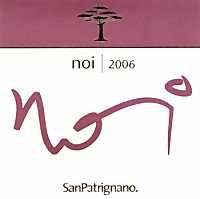
|
|
Colli di Rimini Rosso Noi 2006 |
|
| San Patrignano (Emilia Romagna, Italy) | |
| Grapes: Sangiovese (60%), Cabernet Sauvignon (20%), Merlot (20%) | |
| Price: € 15.00 | Score: |
| Colli di Rimini Rosso Noi shows an intense ruby red color and nuances of ruby red, little transparency. The nose reveals intense, clean, pleasing and refined aromas that start with hints of black cherry, plum and vanilla followed by aromas of violet, black currant, blueberry, tobacco, chocolate and mace. The mouth has good correspondence to the nose, a tannic attack and however balanced by alcohol, good body, intense flavors. The finish is persistent with flavors of black cherry, plum and black currant. Colli di Rimini Rosso Noi ages for 12 months in barrique followed by 4 months of aging in bottle. | |
| Food Match: Broiled meat and barbecue, Roasted meat, Stewed and braised meat with mushrooms | |
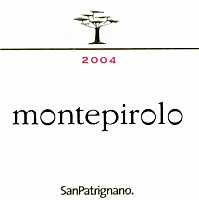
|
|
Colli di Rimini Cabernet Montepirolo 2004 |
|
| San Patrignano (Emilia Romagna, Italy) | |
| Grapes: Cabernet Sauvignon (85%), Merlot (10%), Cabernet Franc (5%) | |
| Price: € 21.00 | Score: |
| Colli di Rimini Cabernet Montepirolo shows an intense ruby red color and nuances of ruby red, little transparency. The nose reveals intense, clean, pleasing, refined and elegant aromas which start with hints of black currant, black cherry and plum followed by aromas of violet, coffee, cocoa, vanilla, tobacco, graphite, black pepper, licorice and eucalyptus. The mouth has good correspondence to the nose, a tannic attack and however balanced by alcohol, full body, intense flavors, pleasing roundness. The finish is persistent with flavors of black currant, black cherry and plum. A well made wine. Colli di Rimini Cabernet Montepirolo ages for 12 months in barrique followed by 18 months of aging in bottle. | |
| Food Match: Game, Roasted meat, Stewed and braised meat, Hard cheese | |
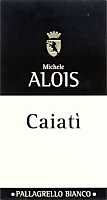
|
|
Caiatì 2007 |
|
| Alois (Campania, Italy) | |
| Grapes: Pallagrello Bianco | |
| Price: € 9.30 | Score: |
| Caiatì shows a brilliant golden yellow color and nuances of golden yellow, very transparent. The nose reveals intense, clean, pleasing and refined aromas which start with hints of plum, apple and pear followed by aromas of citrus fruits, passion fruit, pineapple, medlar, honey and hazelnut. The mouth has good correspondence to the nose, a crisp attack and however balanced by alcohol, good body, intense flavors, agreeable. The finish is persistent with flavors of plum, pear and apple. Caiatì ages in steel tanks. | |
| Food Match: Fish soups, Pasta and risotto with fish, Broiled fish | |

|
|
Trebulanum 2005 |
|
| Alois (Campania, Italy) | |
| Grapes: Casavecchia | |
| Price: € 20.00 | Score: |
| Trebulanum shows a deep ruby red color and nuances of ruby red, little transparency. The nose reveals intense, clean, pleasing, refined and elegant aromas which start with hints of plum, blackberry and black cherry followed by aromas of violet, blueberry, vanilla, tobacco, chocolate, coffee, clover, mace and eucalyptus. The mouth has good correspondence to the nose, a tannic attack and however balanced by alcohol, full body, intense flavors. The finish is persistent with flavors of blackberry, plum and black cherry. Trebulanum ages for 12 months in barrique followed by 8 months of aging in bottle. | |
| Food Match: Roasted meat, Stewed and braised meat with mushrooms, Hard cheese | |
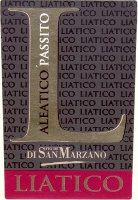
|
|
Aleatico di Puglia Passito Liatico 2007 |
|
| Feudi di San Marzano (Apulia, Italy) | |
| Grapes: Aleatico | |
| Price: € 25.00 | Score: |
| Aleatico di Puglia Passito Liatico shows an intense ruby red color and nuances of ruby red, little transparency. The nose denotes intense, clean, pleasing and refined aromas that start with hints of blackberry, black cherry and violet followed by aromas of plum, blueberry, rose, carob, cinnamon and lavender. The mouth has good correspondence to the nose, a sweet attack and slightly tannic, however balanced by alcohol, good body, intense flavors, agreeable. The finish is persistent with flavors of blackberry, black cherry and blueberry. Aleatico di Puglia Passito Liatico ages in steel tanks. | |
| Food Match: Jam tarts | |
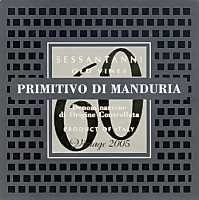
|
|
Primitivo di Manduria Sessantanni 2005 |
|
| Feudi di San Marzano (Apulia, Italy) | |
| Grapes: Primitivo | |
| Price: € 23.00 | Score: |
| Primitivo di Manduria Sessantanni shows a deep ruby red color and nuances of purple red, impenetrable to light. The nose reveals intense, clean, pleasing, refined and elegant aromas that start with hints of blackberry, black cherry and star anise followed by aromas of violet, plum, vanilla, strawberry, blueberry, tobacco, chocolate, cinnamon and menthol. The mouth has good correspondence to the nose, a tannic attack and however balanced by alcohol, full body, intense flavors, pleasing roundness. The finish is persistent with flavors of blackberry, plum and black cherry. Primitivo di Manduria Sessantanni ages for 6 months in barrique. | |
| Food Match: Game, Roasted meat, Braised and stewed meat, Hard cheese | |
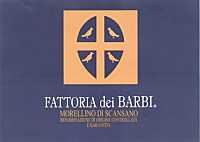
|
|
Morellino di Scansano 2006 |
|
| Fattori dei Barbi (Tuscany, Italy) | |
| Grapes: Sangiovese, Ciliegiolo, Merlot | |
| Price: € 9.00 | Score: |
| This Morellino di Scansano shows a brilliant ruby red color and nuances of ruby red, moderate transparency. The nose denotes intense, clean, pleasing and refined aromas which start with hints of cherry, plum and blackberry followed by aromas of violet, blueberry, vanilla, cinnamon and menthol. The mouth has good correspondence to the nose, a tannic attack and however balanced by alcohol, good body, intense flavors, pleasing crispness. The finish is persistent with flavors of cherry, plum and blackberry. This Morellino di Scansano ages for 8 months in part in cask and in part in steel tanks. | |
| Food Match: Roasted meat, broiled meat and barbecue, Stewed meat, Hard cheese | |
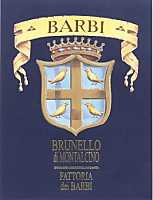
|
|
Brunello di Montalcino 2003 |
|
| Fattori dei Barbi (Tuscany, Italy) | |
| Grapes: Sangiovese | |
| Price: € 23.00 | Score: |
| This Brunello di Montalcino shows a brilliant ruby red color and nuances of garnet red, moderate transparency. The nose reveals intense, clean, pleasing and refined aromas that start with hints of plum, black cherry and dried violet followed by aromas of vanilla, cocoa, tobacco, cinnamon, licorice, mace and menthol. The mouth has good correspondence to the nose, a tannic attack and however balanced by alcohol, full body, intense flavors. The finish is persistent with flavors of black cherry and plum. This Brunello di Montalcino ages for at least 2 years in cask. | |
| Food Match: Game, Roasted meat, Stewed and braised meat, Hard cheese | |
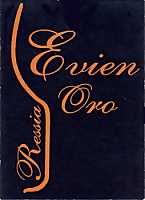
|
|
Evien Oro 2007 |
|
| Ressia (Piedmont, Italy) | |
| Grapes: Muscat Blanc | |
| Price: € 14.00 | Score: |
| Evien Oro shows a brilliant straw yellow color and nuances of straw yellow, very transparent. The nose reveals intense, clean, pleasing and refined aromas which start with hints of grape, peach and banana followed by aromas of apricot, candied fruits, citrus fruits, lychee, apple, pear and sage. The mouth has good correspondence to the nose, a crisp attack and however balanced by alcohol, good body, intense flavors, agreeable. The finish is persistent with flavors of grape, peach and pear. Evien Oro ages for 12 months in barrique followed by 2 months of aging in steel tanks. | |
| Food Match: Pasta with crustaceans, Broiled crustaceans | |
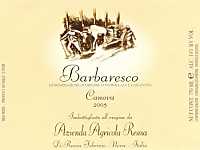
|
|
Barbaresco Canova 2005 |
|
| Ressia (Piedmont, Italy) | |
| Grapes: Nebbiolo | |
| Price: € 27.00 | Score: |
| Barbaresco Canova shows a brilliant ruby red color and nuances of garnet red, moderate transparency. The nose denotes intense, clean, pleasing and refined aromas which start with hints of cherry, plum and rose followed by aromas of raspberry, violet, vanilla, tobacco, cocoa, mace and menthol. The mouth has good correspondence to the nose, a tannic attack and pleasing crispness, however balanced by alcohol, full body, intense flavors. The finish is persistent with flavors of cherry, raspberry and plum. Barbaresco Canova ages in cask. | |
| Food Match: Game, Roasted meat, Braised and stewed meat, Hard cheese | |
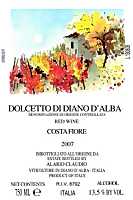
|
|
Dolcetto di Diano d'Alba Costa Fiore 2007 |
|
| Alario (Piedmont, Italy) | |
| Grapes: Dolcetto | |
| Price: € 8.00 | Score: |
| Dolcetto di Diano d'Alba Costa Fiore shows an intense ruby red color and nuances of purple red, little transparency. The nose denotes intense, clean, pleasing and refined aromas which start with hints of plum, cherry and violet followed by aromas of raspberry, blueberry, cyclamen, blackberry and almond. The mouth has good correspondence to the nose, a slightly tannic attack and pleasing crispness, however balanced by alcohol, good body, intense flavors. The finish is persistent with flavors of plum, cherry and blueberry. Dolcetto di Diano d'Alba Costa Fiore ages in steel tanks. | |
| Food Match: Sauteed meat with mushrooms, Cold cuts, Stuffed pasta | |
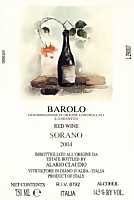
|
|
Barolo Sorano 2004 |
|
| Alario (Piedmont, Italy) | |
| Grapes: Nebbiolo | |
| Price: € 40.00 | Score: |
| Barolo Sorano shows a brilliant ruby red color and nuances of garnet red, moderate transparency. The nose reveals intense, clean, pleasing, refined and elegant aromas which start with hints of cherry, plum and violet followed by aromas of rose, raspberry, strawberry, vanilla, tobacco, cinnamon, cocoa, mace and menthol. The mouth has good correspondence to the nose, a tannic attack and however balanced by alcohol, full body, intense flavors, agreeable. The finish is persistent with flavors of cherry, plum and raspberry. A well made wine. Barolo Sorano ages for 24 months in barrique, 12 months in cask and 12 months in bottle. | |
| Food Match: Game, Roasted meat, Stewed and braised meat, Hard cheese | |
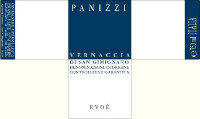
|
|
Vernaccia di San Gimignano Evoè 2006 |
|
| Panizzi (Tuscany, Italy) | |
| Grapes: Vernaccia di San Gimignano | |
| Price: € 15.50 | Score: |
| Vernaccia di San Gimignano Evoè shows a deep golden yellow color and nuances of golden yellow, transparent. The nose reveals intense, clean, pleasing, refined and elegant aromas that start with hints of plum, apple and honey followed by aromas of candied fruits, vanilla, quince jam, pineapple, dried apricot, mango, almond and rosemary. The mouth has good correspondence to the nose, a crisp attack and pleasing roundness, however balanced by alcohol, full body, intense flavors, agreeable. The finish is persistent with flavors of plum, apple, honey and almond. Vernaccia di San Gimignano Evoè ferments and ages on its skins for 10 months in cask. | |
| Food Match: Roasted white meat, Roasted fish, Stuffed pasta | |
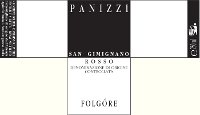
|
|
San Gimignano Rosso Folgòre 2002 |
|
| Panizzi (Tuscany, Italy) | |
| Grapes: Sangiovese (80%), Merlot (10%), Cabernet Sauvignon (10%) | |
| Price: € 23.50 | Score: |
| San Gimignano Rosso Folgòre shows an intense ruby red color and nuances of garnet red, little transparency. The nose reveals intense, clean, pleasing, refined and elegant aromas which start with hints of plum, black cherry and black currant followed by aromas of violet, vanilla, tamarind, tobacco, blueberry, chocolate, clover, cinnamon and eucalyptus. The mouth has good correspondence to the nose, a tannic attack and however balanced by alcohol, good body, intense flavors, agreeable. The finish is persistent with flavors of plum, black cherry and black currant. San Gimignano Rosso Folgòre ages in cask for 14 months. | |
| Food Match: Roasted meat, Stewed and braised meat, Hard cheese | |
|
||||||||
|
DiWineTaste Polls
|
| |||||||
Privacy Policy | |||||||


| Copyright © 2002-2024 Antonello Biancalana, DiWineTaste - All rights reserved |
| All rights reserved under international copyright conventions. No part of this publication and of this WEB site may be
reproduced or utilized in any form or by any means, electronic or mechanical, without permission in writing from DiWineTaste. |